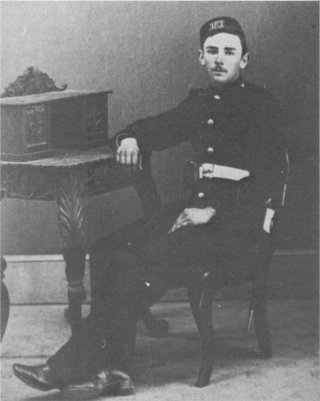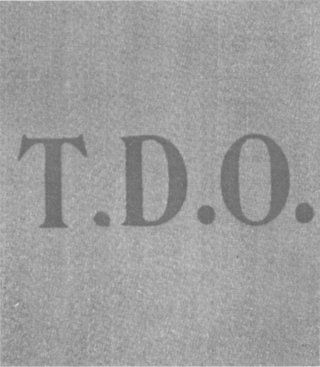

 The South African
The South African
2. SOMERSET EAST VOLUNTEERS.

Somerset East Volunteers
I found the accompanying photograph in the collection of the Bensusan Museum of Photography, Johannesburg.
The subject is not identified or dated but the picture was taken by 'T. H. Howard, Somerset East, Cape Colony.’ This and the fact that the metal badge on the front of the pill box cap comprises an entwined ‘S E V’ monogram, leads me to identify the unit as the Somerset East Volunteers. In The Armed Forces of South Africa, G. Tylden notes that the ‘SOMERSET EAST VOLUNTEERS, or VOLUNTEER HORSE [was] Raised in 1835 for the 6th Kaffir War. Served in the Ninth Kaffir War of 1878, with a strength of 175, under Capt Comley, in the Amatola area.’ The photograph appears to be of about 1880 but the uniform looks more like that of a dismounted unit than Tylden’s 'Volunteer Horse.’
The cap, five buttoned frock and trousers appear to be of the same colour. The cap band, collar, eyed cuff piping and trouser piping appear to be in a similar lighter shade than the uniform’s ground colour. A black ammunition pouch is carried on the white waistband which has a metal snake clasp. On the left hangs a triangular socket bayonet in a black leather scabbard.
Robert Williams.
3. JOHANNESBURG REFORM FORCES.

The Devil's Own
In an album of photographs of Transvaal views and events 1895-1922 in the Cory Library, Grahamstown (Ref: Pic 2715), I came across an interesting device of the reform forces at the time of the Jameson Raid. I am very grateful to the Cory Library for allowing me to reproduce the device here. It is of khaki silk with the letters ‘T.D.O’ in black thread.
The item is captioned in the album as a ‘Badge issued to the contingent of the Reform Troops known as ‘The Devil’s Own.’ It could possibly have been worn as a hat flash or as a lapel token.
Robert Williams.
4. BACKGROUND TO ‘BREAKER MORANT’.
The Editors are indebted to Miss Fiona Barbour, of the McGregor Museum, Kimberley, for bringing to their attention the information relating to 'Breaker’ Morant contained in Despatch: Monthly Journal of the New South Wales Military Historical Society, Vol XVI, No 5 November 1980, which is the source of the following item, and to which acknowledgement is duly made. It was considered that, in view of the great popularity of the film, Breaker Morant, publicly released in South Africa recently, the following information would be of interest to our readers.
Harry Morant was an Englishman of good family background. He had emigrated to Australia, where he procured a reputation for the two — oddly juxtaposed — aptitudes of taming wild horses and writing doggerel verse, published under the pseudonym 'Breaker.’ (His nickname therefore reflects both accomplishments). His final verse, written shortly before his execution on 27 February 1902, is as follows:—
‘In a prison cell I sadly sit,
A d...d crestfallen chappy,
And own to you I feel a bit —
A little bit — unhappy.. .‘
When the Second South African War of 1899-1902 broke out, he joined the South Australian Second Contingent. Subsequently he was commissioned into the Transvaal Constabulary, and on 1 April 1901 joined the Bushveldt Carbineers in the rank of Lieutenant. A likeable, impulsive man, his closest friend was Captain Hunt, of the same regiment, formerly of the 10th Lancers. They had become engaged to sisters in England.
The second member of the accused party was Lieutenant Peter Handcock, an outback Australian who was a Farrier Sergeant in the New South Wales Mounted Infantry, a railway policeman in Pretoria and, finally, a veterinary Lieutenant in the Bushveldt Carbineers. The third accused was George Witton of Lancefield, Victoria, who had been a Gunner in the Victorian Permanent Artillery. He joined the 4th Contingent Imperial Bushmen (Victorian) as Quartermaster-Sergeant for service in South Africa, subsequently transferring to the Bushveldt Carbineers as an officer. There was a fourth member of the accused party, Lieutenant Picton, DCM.
What of the unit itself? It was a regular regiment, and would today perhaps be defined as largely engaged in COIN (Counter-Insurgency) operations. It had been raised with the object of counteracting the Boer guerrillas active in the wild and remote Northern Transvaal, after the territory had been annexed by Great Britain on 25 October 1900. The unit’s headquarters were in Pietersburg; but Hunt, Morant and others were members of a detachment stationed in the remote Spelonken area, approximately 150 km to the north of Pietersburg. Within such an isolated context, the detachment naturally enjoyed great autonomy in its method of operations.
Morant was incensed at what he considered to be the murder and subsequent mutilation of his comrade, Hunt. (If, incidentally, Hunt had indeed been mutilated, this was an extremely rare occurrence in the War.) Nine Boer prisoners (including one Visser) were shot on his orders, and the German missionary, C. A. D. Hesse was found murdered. On 23 October 1901 a Court of Inquiry was held in Pietersburg. The Defence Counsel was a Major J. F. Thomas. On 16 January 1902 Morant, Handcock, Witton and Picton were court-martialled on charges of the murder of Visser and the others. Found guilty, the first three were sentenced to death by firing squad. Picton was cashiered, being found guilty of manslaughter. On 26 February the accused were informed of the sentence. Kitchener proved totally impervious to recommendations of mercy with regard to Morant and Handcock, and confirmed their sentences. However, Witton’s sentence was commuted to penal servitude for life. To reiterate, the executions were carried out on the following day. Morant and Handcock lie buried together beneath a cross in Church Street West Cemetery, Pretoria. Witton was subsequently pardoned, following a great deal of agitation. He was released on 11 August 1904 and on 12 November of the same year returned to Australia, where he wrote his book, tellingly entitled, Scapegoats of the Empire. It is germane to note that, since the executions of Morant and Handcock, no Australian has ever been tried on a capital charge by a British Army Court.
There is an interesting contemporary postscript to this story. One of the victims of the Bushveldt Carbineers was Edoud Boukan, a Hollander who had settled in the Transvaal. One evening he was arrested by some Australians in the area beyond Pietersburg. His story that he was a prospector was not believed and he was condemned to death as a spy or guerrilla. Boukan’s servant concealed himself and witnessed his master digging his own grave, whereupon he (Boukan) was shot. Boukan’s grave was subsequently located for his grand-daughter, Mrs Strijdom, by Mr Maurice Gough-Palmer, Secretary of the British Forces Committee of the SA War Graves Board and Vice-Chairman of the Military History Society. Mr Gough-Palmer informed Mrs Strijdom that she could visit her grandfather’s grave at Ballymore, a farm between Louis Trichardt and Elim, where he lies buried alongside seven other burghers. The records of the War Graves Board state that Boukan, a man of 45, died on 23 August 1901.
2. THE EARLY USE OF KHAKI (Vol 5 No 3, p 123)
This question of the early use of khaki has generated considerable interest. We have received the following letter in this connection
(i) Miss Fiona Barbour, of the McGregor Museum Kimberley, has kindly sent us documentation which amplifies and supplements the information provided in the Editors’ Reply to Question No. 1 (‘The Early Use of Khaki’) in the Military History Journal, Vol 5 No 3, June 1981, p 123. The document consists of an item in the Journal of the Society for Army Historical Research, Vol 15, 1936, pp 181-183 (Item No 189).
(ii) Mr Richard Tomlinson states:
With reference to the continuing correspondence in the Journal on the early use of khaki, I have recently come
across an interesting reference in The Red Soldier Letters from the Zulu War, 1879, by Frank Emery (Hodder
and Stoughton, 1977). On p 143, in a letter dated 16 March 1879 by Capt Walter Parke Jones, commanding
the 5th Field Coy Royal Engineers, the writer states:
'my white helmet dyed with mimosa bark to a brown colour and denuded of its brass ornaments.’
Can any of your readers cite other examples of the use of the bark of mimosa or any other tree for dying white helmets? I can only recall having seen mention of coffee, dung and various types of earth being used for this task, but wood bark is surely a very obvious dye source.
Return to Journal Index OR Society's Home page
South African Military History Society / scribe@samilitaryhistory.org